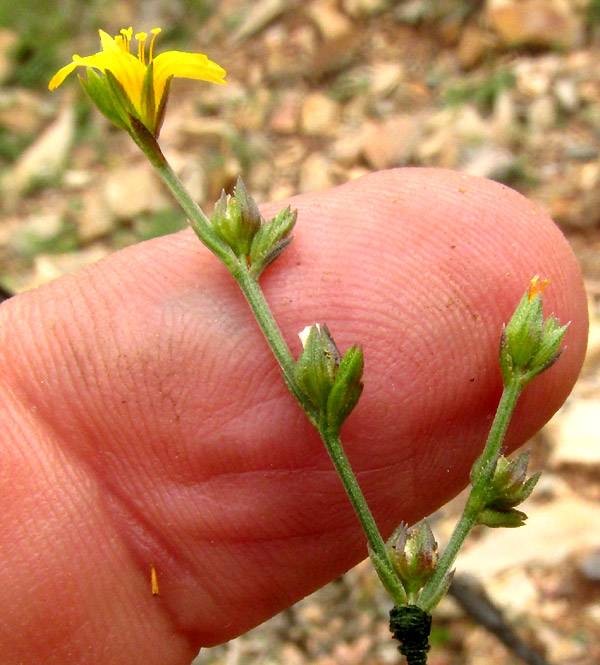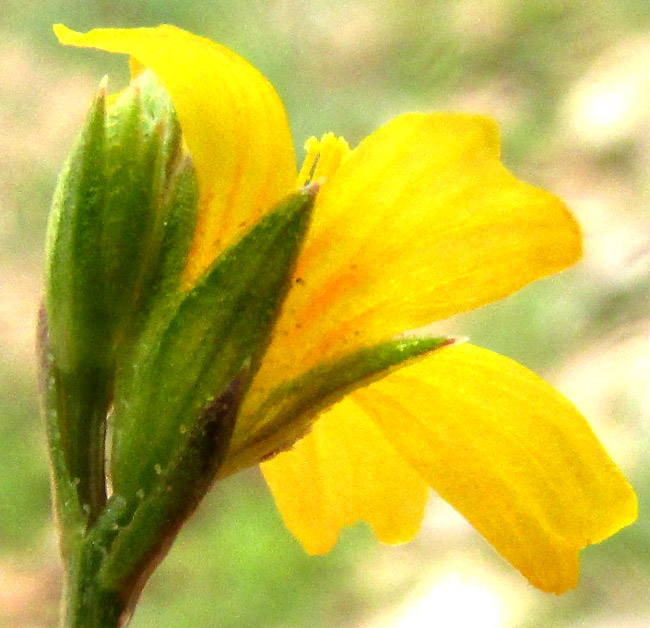Excerpts from Jim Conrad's
Naturalist Newsletter
Entry from field notes dated August 31, 2023, taken in Los Mármoles National Park in the Eastern Sierra Madre mountains, Hidalgo state, MÉXICO, along steeply climbing road heading eastward out of town of Trancas {on maps designated "Morelos (Trancas)"} toward Nicolás Flores; juniper/pine forest on limestone bedrock; elevation ~2,300m (~7,550ft); ~N20.80°, ~W99.25°
SCHIEDE'S FLAX

On a steep tallus slope below a roadcut through limestone, in a spot receiving full sunlight during part of the day, and during a long-term drought, the above lanky-looking wildflower's long, slender and somewhat stiff stems seemed to be thriving.

Flowers blossomed at the tips of inflorescence branches, while below each open blossom flowers which had blossomed earlier showed progressively more mature ovaries, the lowest bearing almost-ripe, capsular-type fruits containing several seeds.

The blossom was classic 5-5-5 -- five sepals, five petals and five stamens. Like a tiny green pea, the ovary nestled at the flower's bottom. The ovary bore more than one styles, which were separated from one another all the way to their bases.
We've seen flowers very similar to this, but variously different. They were "wild flaxes," genus Linum, of the Flax Family, the Linaceae. For example, there was Linum scabrellum and Linum rupestre. About 200 flax species currently are recognized worldwide, occurring in temperate and subtropical zones. In this part of upland central Mexico, about six fairly similar species have been documented, so more details are needed to figure out which one this is.

Below the corolla, the green calyx's sepals were typical of others we've seen: somewhat stiff, prominent longitudinal veins, and gradually narrowing to a sharp point. Sepal margins among the flaxes can be glandular or not. In the above picture they're hard to see on the sepals, if they're present, but on margins of the scale-like bracts below the flower, notice the widely spaced, pale, stalked glands.

At the above picture's lower, right, on a flower which lost its petals after pollination, stalked glands along the sepal margins are clearly visible. In that same flower, atop the ovary, notice that at least three styles are visible, their tips curving outward. The yellow petals on my fingertip show that they are not fused at their bases, which is right for Linum flowers. Finally, here's what our plant's leaves looked like:

On this species, each stem node can produce two or more leaves, often four. This is a feature eliminating numerous other flax species. Also the picture shows that this species' main stem readily branches.
In our part of upland central Mexico, if you have a yellow-flowered flax whose ovaries produce styles completely separated from one another, some stem nodes bear up to four leaves, vegetative parts are hairless or nearly so, and the leaves are more than 2mm wide (1/16th inch), you have LINUM SCHIEDEANUM, in English often known as Schiede's Flax.
Our plant bears an English name because it occurs in dry upland parts of New Mexico and Texas, though mostly it's found from northeastern Mexico south primarily in the Eastern Sierra Madres, and on south perhaps as far south as Honduras. It inhabits diverse highland habitats, forests to pasturelands and scrub, especially on limestone.
Flaxes in general have a long history of human use. The most famous species, the blue-flowered, Eurasian Common Flax, has been used at least for the last 30,000 years, as a source of fibers. In modern times its fiber has been woven into the textile linen, plus its oily, nutritional seeds are much exploited commercially. Several Linum species are grown as garden ornamentals.
Little information is available about the usefulness of Schiede's Flax, one reason probably being the difficulty of distinguishing the species from other flaxes. However, in the 2023 study by Angel Josabad Alonso-Castro and others entitled "Concomitant use of allopathic medicine and herbal products for weightloss among people with overweight or obesity from Central Mexico," Linum schiedeanum was listed as one of twelve species reported used by people concerned about their obesity. In fact, flax leaves have been eaten historically, despite their small size. The above picture shows that Schiede's Flax leaves are relatively thick, almost succulent looking, like those of highly edible Purslane.
By the way, Schiede's Flax is named for Christian Julius Wilhelm Schiede, who was a German physician and botanist who emigrated to Mexico in 1828. He'd hoped to survive by selling collected plants and animals for sale to European museums, but the income didn't enable him to continue this for long. His base of operation was in Xalapa, Veracruz.